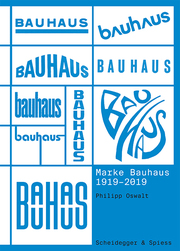Detailansicht
Marke Bauhaus 1919-2019
Der Sieg der ikonischen Form über den Gebrauch
ISBN/EAN: 9783858816207
Umbreit-Nr.: 6134311
Sprache:
Deutsch
Umfang: 336 S.
Format in cm: 1.8 x 28 x 20.5
Einband:
Paperback
Erschienen am 12.12.2019
- Zusatztext
- Nicht Funktion und Gebrauch zeichnen das Bauhaus aus, sondern Symbolik. Ob Quadrat, Dreieck oder Kreis, ob Wagenfeld-Lampe, Schlemmer-Kopf oder weisse Kuben mit Flachdach: Das Bauhaus hat ikonische Bildzeichen und einen Stil kreiert, der weder funktional noch sozial ist, aber visuell prägnant. BauhausGründer Walter Gropius zielte von Anfang an darauf, aus dem Bauhaus eine Marke zu entwickeln mit Erfolg. Sei es in Konsum, Politik oder Kultur: Mehr als achtzig Jahre nach seiner Schliessung ist das Bauhaus präsenter als je zuvor. Es ist inzwischen zu einer partizipativen Marke geworden, die nicht mehr zentral gesteuert werden kann, sondern an der unzählige Produzenten und Konsumenten mitgeschrieben haben. Das einstige Verspechen nach Funktionalität und sozialer Verpflichtung bleibt dabei allerdings uneingelöst. Das Buch von Philipp Oswalt, ehemaliger Direktor der Stiftung Bauhaus Dessau, widmet sich anhand zahlreicher Bildbeispiele und gehaltvoller Texte dieser prominenten Markenbildung und verwendung.
- Autorenportrait
- Philipp Oswalt war von 2009-2014 Direktor der Stiftung Bauhaus Dessau und ist Mitbegründer des Projekt Bauhaus. Seit 2006 ist er Professor für Architekturtheorie und Entwurf an der Universität Kassel. 807280156591LangtextWhen Lulu was premiered in Zurich in 1937, it immediately created a scandal. Even though the sexually explicit topic and the somewhat dubious characters of the drama barely cause a stir in the modern theatre world, stagings of the opera are still accompanied by divided opinion as to how to interpret the figure of Lulu and - since the advent of Friedrich Cerha's completion - which version of the originally unfinished work to use. Arthaus presents a staging produced at the Zurich Opera, which offered an unusual and remarkable solution: it returned to the incomplete two-act version seen at the premiere. The finale consists of the Variations and the Adagio from the Lulu Suite, which conclude the work as a kind of coda. Musical Director Franz Welser-Möst felt that the unfinished state of the work was not merely due to the composer's deathin 1935, but also because Berg himself seems to have changed his concept of the opera. It seems that Berg's final ideas, including the appearance of Lulu's suitor as the reincarnation of her previous husbands in the third act and the equation of Dr. Schön with Jack the Ripper, fit Sven Eric Bechtolf's interpretation of the title figure extremely well. Opera performance and bonus film together provide the viewer of this DVD with an enlightened approach to one of the few post-tonal operas that enjoy ongoing success on stage.
